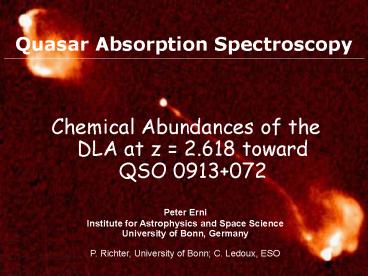Quasar Absorption Spectroscopy _____________________________________________________________________ - PowerPoint PPT Presentation
1 / 22
Title:
Quasar Absorption Spectroscopy _____________________________________________________________________
Description:
Quasar Absorption Spectroscopy. Chemical Abundances of the DLA at z = 2.618 ... UVES The VLT UV-Visual Echelle Spectrograph. UVES at VLT UT2 (Kueyen), Nasmyth B ... – PowerPoint PPT presentation
Number of Views:51
Avg rating:3.0/5.0
Title: Quasar Absorption Spectroscopy _____________________________________________________________________
1
Quasar Absorption Spectroscopy___________________
__________________________________________________
__________________________________________________
__________________________________________________
________________________________
- Chemical Abundances of the DLA at z 2.618
toward QSO 0913072
Peter Erni Institute for Astrophysics and Space
Science University of Bonn, Germany P. Richter,
University of Bonn C. Ledoux, ESO
2
Introduction QALs Quasi-stellar object (QSO)
Absorption-Line systems
The Quasar 0913072
Results Interpretation
3
Introduction QALs Quasi-stellar object (QSO)
Absorption-Line systems
4
QSO Absorption-Line Systems (QALs)
column density N(HI) cm-2
DLA
1020
sub-DLA
1019
LLS
1017.2
Lya Forest
5
UVES The VLT UV-Visual Echelle Spectrograph
UVES VLT
GHRS HST
FUSE
UVES VLT
HIRES KECK
HUT
l A
4000
2000
0
6000
8000
10000
6
UVES The VLT UV-Visual Echelle Spectrograph
UVES at VLT UT2 (Kueyen), Nasmyth B
7
The Quasar 0913072
This is the only DLA where CII is not saturated
an therefore N(CII) can be reliably measured.
8
(No Transcript)
9
Our data
- Resolution R ? 45,000
- Exposure t 13.7 h
- S/N ? 150
- Source ESO Archive
- Range l 3500 - 10200 Å(Lyman break at 2889 Å)
10
Lya, Lyb and Lyg (QSO 0913) at zabs2.618
11
Results Interpretation
- Characteristic Parameter
- Comparison with previous observations
- Metal abundances from the DLA at zabs 2.618
- Some conclusions
12
Characteristic Parameters
- Doppler Parameter b
- (thermal broadening)
- Equivalent Width W
- (total strength of the absorption)
- ? Curve of Growth (COG)
- Column Density logN(X)
13
Comparing old and new data
ESO 3.6m (F/8 Cassegrain) and 3.5m NTT at La
Silla (1998)
ESO 8.2m VLT (Nasmith, UT2) at Paranal (2002)
C. Ledoux et al. 2003
14
O Very low overall metallicity ? Enriched by
only a few stellar generations
N Very nitrogen deficient ? Characteristic
pattern for SNe II
C Extremely underabundant ? Implies certain
mass range for SNe II progenitor stars
15
Lowest C/H abundance ever found in QALs
- Q0913072 zabs 2.618 DLA CII/H -2.85 ?
0.08 - HE0001-2340 zabs 2.187 sub-DLA CII/H
-1.76 ? 0.21 1) - QHE 09401050 zabs 2.917 LLS C/H -2.93
? 0.15 2) - Earlier measurements of Lya clouds showed C/H
gt -2.4 3) - Lowest value for Galactic metal poor stars
C/H -3.6 4) - _________________________________________
16
N/a ratio versus a-element abundance for DLAs
and HII galaxies
Centurión et al. 2003
17
N/Si ratio versus nitrogen abundance for DLAs
Molaro et al. 2004
18
Comparing the metal abundances in the five
sub-components
Very similar metallicities in all five
components Strengthen the assumption that
sub-DLAs and DLAs sample similar galactic
structures with different line-of-sight
geometries (Maller et al. 2003) rather than being
two different classes of proto-galactic objects
(Péroux et al. 2003).
- Numerical investigations (Kawata et al. 2001)
showed that a typical SNII is producing - significantly more magnesium (731)
- more silicon (51) and
- slightly less iron (0.81) than a typical
SNIa.
19
- High radial velocities no neutral gas (OI)
- ? strong UV exposure
- Low radial velocities no double ionized gas
(SiIII) - ? weaker UV exposure
- Our speculations - oblate, disk-like structure
- - no differential rotation (rather close to
dj/dtCST) - - dominant Dark Matter halo
20
Some Conclusions
- What object ist this DLA?
- protogalactic (oblate?) structure
- enriched by the very first generations of stars
(mostly SNeII) - relict of the very early metal enrichment in the
Universe
21
Lookback Time
Wm 0.27 H0 71 WL 0.73
age of the protogalaxy ? 2.54 Gyr (t0 13.67
Gyr)
22
Data Analysis with Voigt-Profil
The frequency dependence of the absorption
capability is given by the Lorenz function
In real matter, the atoms move about with
Doppler velocity according to the temperature,
descirbe by the Maxwellian velocity distribution
function
The real frequency dependent profile of
absorptoin is given by the convolution of the two
Voigt-Funktion































